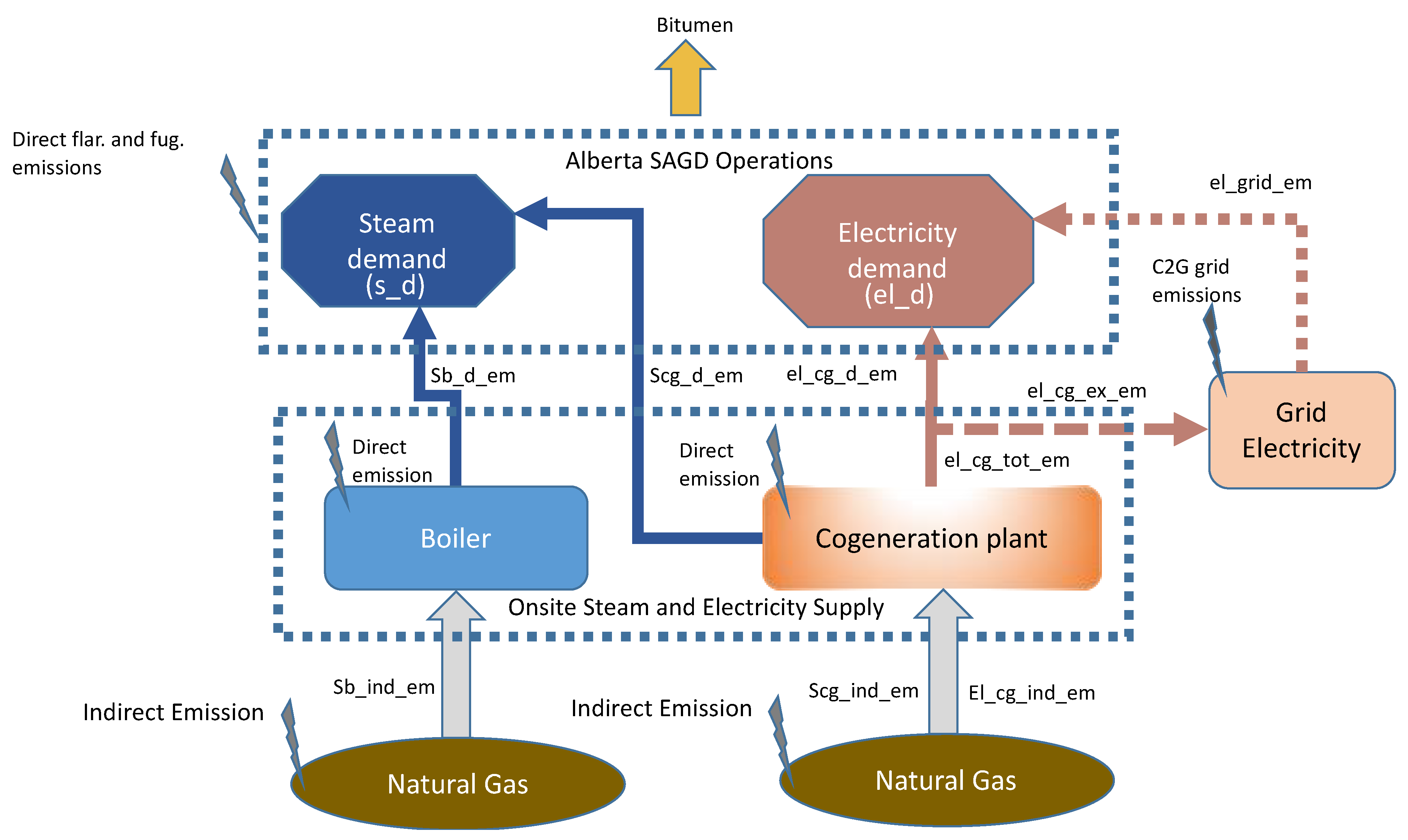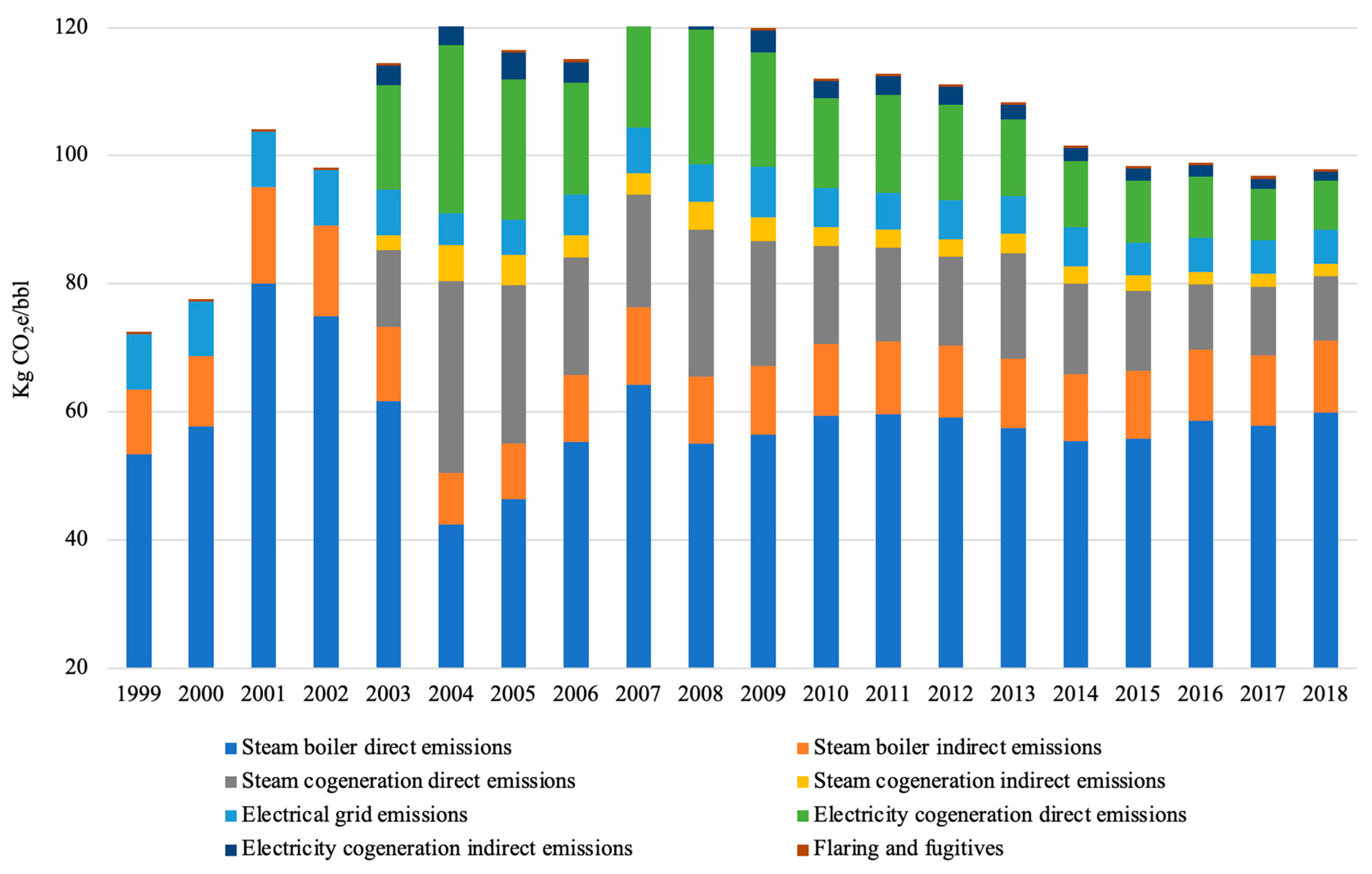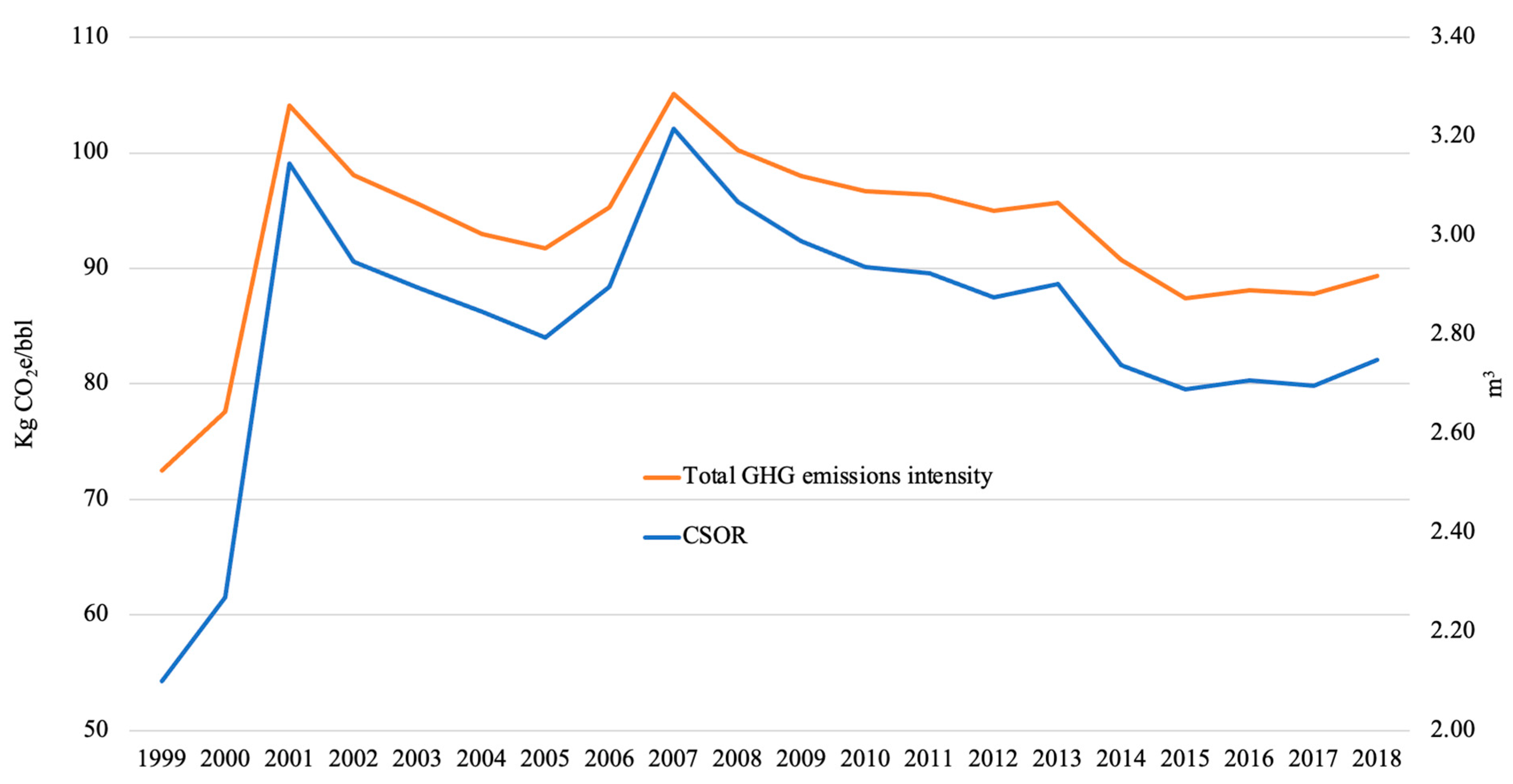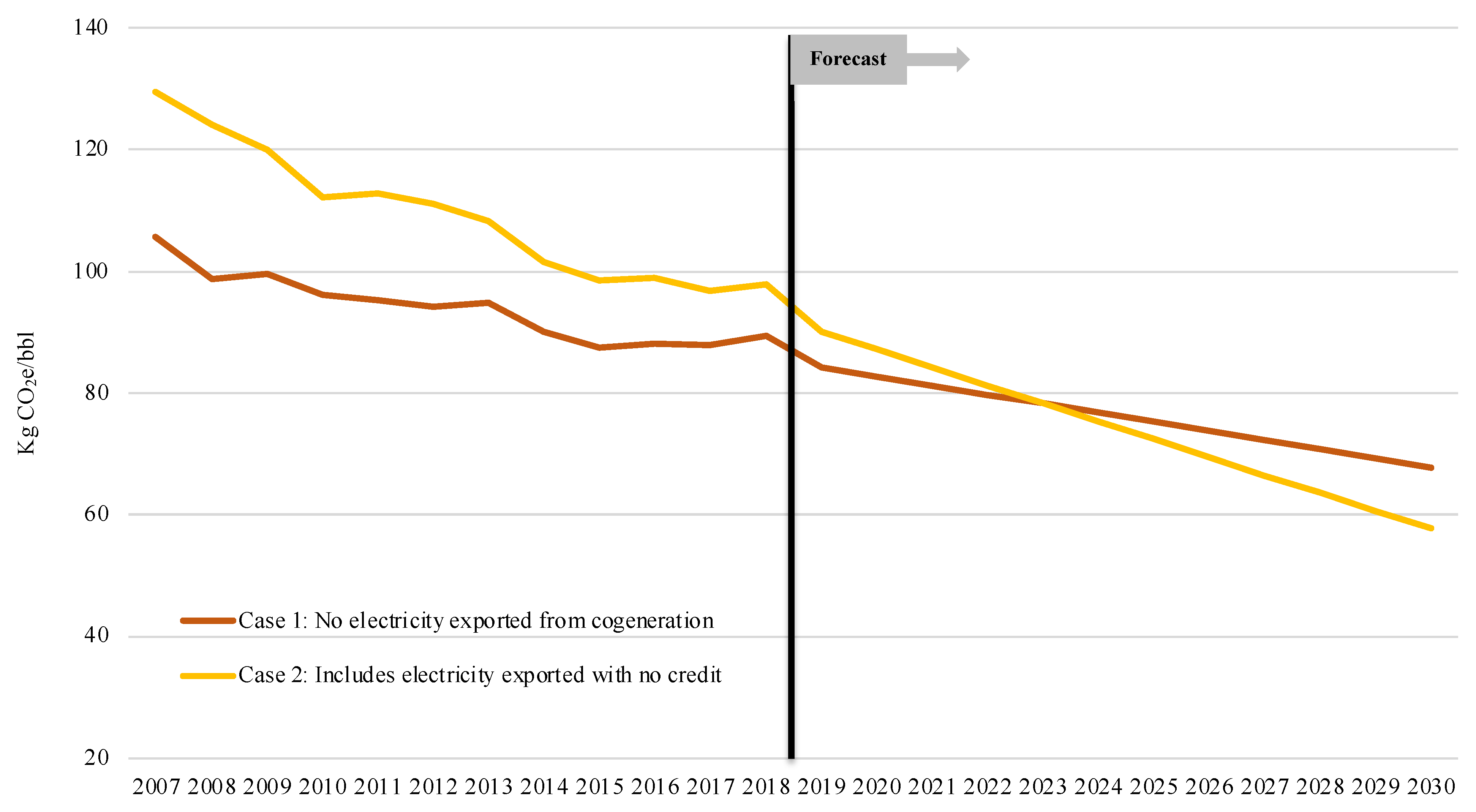Policy Insights to Accelerate Cleaner Steam-Assisted Gravity Drainage Operations
Abstract
1. Introduction
2. Materials and Methods
2.1. Data Collection
2.2. Process Calculations
- Steam boiler direct emissions: direct emissions associated with combustion of natural gas to produce steam using boiler;
- Steam boiler indirect emissions: indirect (upstream) emissions associated with production of natural gas that is used to produce steam in boiler;
- Steam cogeneration direct emissions: direct emissions associated with combustion of natural gas to produce steam using cogeneration;
- Steam cogeneration indirect emissions: indirect (upstream) emissions associated with production of natural gas that will be used to produce steam using cogeneration;
- Electricity grid emissions: upstream emissions associated with electricity from grid production used in steam production;
- Electricity cogeneration direct emissions: direct emissions associated with production of electricity using cogeneration installed in SAGD facilities;
- Electricity cogeneration indirect emissions: indirect (upstream) emissions associated with production of natural gas that will be used to produce electricity using cogeneration installed in SAGD facilities;
- Flaring and fugitive emissions: direct flaring and fugitive emissions associated with operations of production of crude bitumen.
3. Results
3.1. GHG Emission Intensity
3.1.1. Case 1
3.1.2. Case 2
3.1.3. Case 3
3.2. GHG Emissions Intensity and Steam-to-Oil Ratio
3.3. Sensitivity Analysis
3.4. Comparison of Results
4. Discussion
4.1. Factors Affecting SAGD Historical Performance
4.2. Role of Policy-Makers: Insights to Accelerate Improvements of SAGD GHG Performance
4.3. Projections for Future Performance of SAGD
5. Conclusions
Supplementary Materials
Author Contributions
Funding
Data Availability Statement
Conflicts of Interest
References
- Brandt, A.R. Variability and uncertainty in life cycle assessment models for greenhouse gas emissions from Canadian Oil Sands production. Environ. Sci. Technol. 2011, 46, 1253–1261. [Google Scholar] [CrossRef]
- AER (Alberta Energy Regulator). Alberta Energy Outlook, ST98: Executive Summary. 2021. Available online: https://static.aer.ca/prd/documents/sts/ST98/2021/st98-2021-executivesummary.pdf (accessed on 25 September 2021).
- Gates, I.D.; Wang, J. Evolution of in situ oil sands recovery technology: What happened and what’s new? In Proceedings of the Society of Petroleum Engineers Heavy Oil Conference and Exhibition, Kuwait City, Kuwait, 12–14 December 2011. [Google Scholar]
- IHS Markit. Greenhouse Gas Intensity of Oil Sands Production: Today and in the Future. 2018. Available online: https://ihsmarkit.com/forms/contactinformation.html?efid=tFSzO+2aeGqpKuUQPMWZ3Q== (accessed on 15 February 2021).
- NRC (Natural Resources Canada). Crude Oil Facts. 2018. Available online: https://www.nrcan.gc.ca/energy/facts/crude-oil/20064#L6 (accessed on 5 March 2021).
- ECCC (Environment and Climate Change Canada). National Inventory Report 1990–2018: Greenhouse Gas Sources and Sinks in Canada. 2020. Available online: https://publications.gc.ca/collections/collection_2020/eccc/En81-4-2018-1-eng.pdf (accessed on 25 September 2021).
- Butler, R.M. Thermal Recovery of Oil and Bitumen; Prentice-Hall Inc.: Upper Saddle River, NJ, USA, 1991; ISBN 9780139149535. [Google Scholar]
- Layzell, D.B.; Narendran, M.; Shewchuk, E.; Sit, S.P. SAGD cogeneration: Reducing the carbon footprint of oilsands production and the Alberta grid. CESAR Scenar. 2016, 1, 1–37. [Google Scholar]
- Layzell, D.B.; Narendran, M.; Shewchuk, E.; Sit, S.P. Cogeneration options for a 33,000 BPD SAGD facility: Greenhouse gas and economic implications. CESAR Scenar. 2016, 1, 1–54. [Google Scholar]
- Giacchetta, G.; Leporini, M.; Marchetti, B. Economic and environmental analysis of steam assisted gravity drainage (SAGD) facility for oil recovery from Canadian Oil Sands. Appl. Energy 2015, 142, 1–9. [Google Scholar] [CrossRef]
- Gates, I.D.; Larter, S.R. Energy efficiency and emissions intensity of SAGD. Fuel 2014, 115, 706–713. [Google Scholar] [CrossRef]
- Nimana, B.; Canter, C.; Kumar, A. Energy consumption and greenhouse gas emissions in the recovery and extraction of crude bitumen from Canada’s oil sands. Appl. Energy 2015, 143, 189–199. [Google Scholar] [CrossRef]
- Nimana, B.; Canter, C.; Kumar, A. Life cycle assessment of greenhouse gas emissions from Canada’s oil sands-derived transportation fuels. Energy 2015, 88, 544–554. [Google Scholar] [CrossRef]
- Bergerson, J.A.; Oyeshola, K.; Charpentier, A.D.; Sleep, S.; Maclean, H.L. Life cycle greenhouse gas emissions of current oil sands technologies: Surface mining and in situ applications. Environ. Sci. Technol. 2012, 46, 7865–7874. [Google Scholar] [CrossRef] [PubMed]
- McCann, P.; Magee, T. Crude oil greenhouse gas life cycle analysis helps assign values for CO2 emissions trading. Oil Gas J. 1999, 97, 38–43. [Google Scholar]
- Jacobs Consultancy for Alberta Energy Research Institute. Life Cycle Assessment of North American and Imported Crudes. 2009. Available online: http://seeds4green.net/sites/default/files/life%20cycle%20analysis%20jacobs%20final%20report.pdf (accessed on 15 February 2021).
- El-Houjeiri, H.M.; Brandt, A.R.; Duffy, J.E. Open-source LCA tool for estimating greenhouse gas emissions from crude oil production using field characteristics. Environ. Sci. Technol. 2013, 47, 5998–6006. [Google Scholar] [CrossRef]
- GREET. The Greenhouse Gases, Regulated Emissions, and Energy Use in Transportation (GREET) Model, GREET1 2018, Argonne National Laboratories for U.S. Department of Energy. Available online: https://greet.es.anl.gov/ (accessed on 10 February 2021).
- NRC (Natural Resources Canada). GHGenius Version 5.0d; Natural Resources Canada: Ottawa, ON, USA, 2018. Available online: http://www.ghgenius.ca (accessed on 10 February 2021).
- Charpentier, A.D.; Kofoworola, O.; Bergerson, J.A.; MacLean, H.L. Life cycle greenhouse gas emissions of current oil sands technologies: GHOST model development and illustrative application. Environ. Sci. Technol. 2011, 45, 9393–9404. [Google Scholar] [CrossRef] [PubMed]
- Orellana, A.; Laurenzi, I.J.; MacLean, H.L.; Bergerson, J.A. Statistically enhanced model of in situ oil sands extraction: An evaluation of variability in greenhouse gas emissions. Environ. Sci. Technol. 2018, 52, 947–954. [Google Scholar] [CrossRef]
- Sleep, S.; Guo, J.; Laurenzi, I.J.; Bergerson, J.A.; Maclean, H.L. Quantifying variability in well-to-wheel greenhouse gas emission intensities of transportation fuels derived from Canadian oil sands mining operations. J. Clean. Prod. 2020, 258, 120639. [Google Scholar] [CrossRef]
- Pinto, H.; Wang, X.; Gates, I. On the ratio of energy produced to energy injected in SAGD: Long-term consequences of early stage operational decisions. J. Pet. Sci. Eng. 2021, 199, 108271. [Google Scholar] [CrossRef]
- Cheng, L.; Liu, H.; Huang, S.; Wu, K.; Chen, X.; Wang, D.; Xiong, H. Environmental and economic benefits of Solvent-Assisted Steam-Gravity Drainage for bitumen through horizontal well: A comprehensive modeling analysis. Energy 2018, 164, 418–431. [Google Scholar] [CrossRef]
- Austin-Adigio, M.; Gates, I. Cleaner production from steam-assisted gravity drainage using seismic-based automated control. J. Clean. Prod. 2019, 209, 1139–1151. [Google Scholar] [CrossRef]
- Katta, A.K.; Davis, M.; Subramanyam, V.; Dar, A.F.; Mondal, M.A.H.; Ahiduzzaman, M.; Kumar, A. Assessment of energy demand-based greenhouse gas mitigation options for Canada’s oil sands. J. Clean. Prod. 2019, 241, 118306. [Google Scholar] [CrossRef]
- Ashrafi, O.; Zamor, O.; Navarri, P. Impact of carbon capture technologies on GHG emissions from oil sands in-situ facilities: A system prospective. Appl. Therm. Eng. 2021, 188, 116603. [Google Scholar] [CrossRef]
- Gross, R.; Hanna, R.; Gambhir, A.; Heptonstall, P.; Speirs, J. How long does innovation and commercialization in the energy sectors take? Historical case studies of the timescale from innovation to widespread commercialization in energy supply and end use technology. Energy Policy 2018, 123, 682–699. [Google Scholar] [CrossRef]
- Province of Alberta. Responsible Energy Development Act General Regulation. 2019. Available online: http://www.qp.alberta.ca/1266.cfm?page=2013_090.cfm&leg_type=Regs&isbncln=9780779807345 (accessed on 10 February 2021).
- Doluweera, G.H.; Jordaan, S.M.; Moore, M.C.; Keith, D.W.; Bergerson, J.A. Evaluating the role of cogeneration for carbon management in Alberta. Energy Policy 2011, 39, 7963–7974. [Google Scholar] [CrossRef]
- Alberta Government. Standard for Completing Greenhouse Gas Compliance Reports. 2017. Available online: https://open.alberta.ca/dataset/8acc4e6f-6227-49d0-8a9b-14b8790c8e67/resource/b1fc8461-70b3-4bed-8d37-f64d22775780/download/standardghgcompliancereports-oct2017.pdf (accessed on 15 February 2021).
- CERI (Canadian Energy Research Institute). Oil Sands Industry Energy Requirements and Greenhouse Gas (GHG) Emissions Outlook (2015–2050). 2015. Available online: https://www.nrcan.gc.ca/sites/www.nrcan.gc.ca/files/energy/energy-resources/CERI_Study_151_Full_Report.pdf (accessed on 15 February 2021).
- Alberta Government. Notice of Change for Emission Factor for Increase Grid Electricity Usage. 2011. Available online: https://www.csaregistries.ca/files/projects/7758_5940_AEOR_OffsetProjectReport_20160101_20160930.pdf (accessed on 10 February 2021).
- Alberta Government. Carbon Offset Emission Factor Handbook. 2015. Available online: https://open.alberta.ca/dataset/dd23dec0-e408-49b7-8bdc-151cc1ce58f5/resource/18f3a5f5-6370-467b-be5a-664330014723/download/2015-carbonemissionhandbook-mar11.pdf (accessed on 10 February 2021).
- Government of Canada. Open Government, Greenhouse Gas Reporting Program (GHGRP) Facility Greenhouse Gas (GHG) Data. 2019. Available online: https://open.canada.ca/data/en/dataset/a8ba14b7-7f23-462a-bdbb-83b0ef629823 (accessed on 10 January 2021).
- Rosenfeld, J.; Pont, J.; Law, K.; Hirshfeld, D.; Kolb, J. Comparison of North American and Imported Crude Oil Lifecycle GHG Emissions; TIAX LLC for the Alberta Energy Research Institute: Cupertino, CA, USA, 2009. Available online: http://www.assembly.ab.ca/lao/library/egovdocs/2009/aleri/173913.pdf (accessed on 15 February 2021).
- Bunio, G.L.; Gates, I.D. Innovation, Motivation, and Fear: A Novel Perspective for Unconventional Oil. In Proceedings of the Society of Petroleum Engineers Unconventional Resources Conference and Exhibition-Asia Pacific, Brisbane, Australia, 11–13 November 2013. [Google Scholar]
- Hannouf, M.; Assefa, G. The role of sustainability resources of large greenhouse gas emitters: The case of corporations in Alberta, Canada. Sustainability 2017, 9, 182. [Google Scholar] [CrossRef]
- Lehmann, A.; Zschieschang, E.; Traverso, M.; Finkbeiner, M.; Schebek, L. Social aspects for sustainability assessment of technologies—challenges for social life cycle assessment (SLCA). Int. J. Life Cycle Assess. 2013, 18, 1581–1592. [Google Scholar] [CrossRef]
- Flint, L. Bitumen & Very Heavy Crude Upgrading Technology—A Review of Long Term R&D Opportunities LENEF Consulting Ltd. Available online: https://collections.lib.utah.edu/details?id=213965 (accessed on 10 February 2021).
- Englander, J.G.; Bharadwaj, S.; Brandt, A.R. Historical trends in greenhouse gas emissions of the Alberta oil sands (1970–2010). Environ. Res. Lett. 2013, 8, 044036. [Google Scholar] [CrossRef][Green Version]






| This Study (Case 1) | This Study (Case 2) | This Study (Case 3) | Charpentier et al. [20] | Nimana et al. [12] | IHS Markit Study [4] | Orellana et al. [21] | TIAX (Rosenfeld et al. [36]) | GREET [18] | GHGenius (Nimana et al. [12]) | Jacobs [16] | |
|---|---|---|---|---|---|---|---|---|---|---|---|
| Cogener-ation case | 85–101 | 143–211 | 30–50 b | 61–94 (following Case 1) d | 38–162 e (following Case 3) | - | - | 55 | - | - | 14 i |
| No cogener-ation case | 72–106 | 72–106 | 72–106 | 65–110 (following Case 1) d | 60.6–220 (following Case 3) e | - | - | 68 | 91 h | 102 h | 85 |
| Overall industry | 72–106 (1999–2013) a Average is 94 | 72–129.4 | 75–80.5 c (2009–2017) | - | - | 71.5–78.5 f (2009–2017) | 91 average emissions intensity (1999–2013) g | - | - | - | - |
Publisher’s Note: MDPI stays neutral with regard to jurisdictional claims in published maps and institutional affiliations. |
© 2021 by the authors. Licensee MDPI, Basel, Switzerland. This article is an open access article distributed under the terms and conditions of the Creative Commons Attribution (CC BY) license (https://creativecommons.org/licenses/by/4.0/).
Share and Cite
Hannouf, M.; Assefa, G.; Gates, I. Policy Insights to Accelerate Cleaner Steam-Assisted Gravity Drainage Operations. Energies 2022, 15, 86. https://doi.org/10.3390/en15010086
Hannouf M, Assefa G, Gates I. Policy Insights to Accelerate Cleaner Steam-Assisted Gravity Drainage Operations. Energies. 2022; 15(1):86. https://doi.org/10.3390/en15010086
Chicago/Turabian StyleHannouf, Marwa, Getachew Assefa, and Ian Gates. 2022. "Policy Insights to Accelerate Cleaner Steam-Assisted Gravity Drainage Operations" Energies 15, no. 1: 86. https://doi.org/10.3390/en15010086
APA StyleHannouf, M., Assefa, G., & Gates, I. (2022). Policy Insights to Accelerate Cleaner Steam-Assisted Gravity Drainage Operations. Energies, 15(1), 86. https://doi.org/10.3390/en15010086








